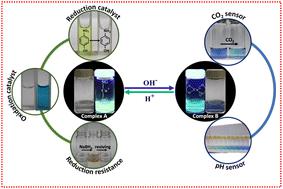Our official English website, www.x-mol.net, welcomes your feedback! (Note: you will need to create a separate account there.)
Switchable catalysis and CO2 sensing by reduction resistant, luminescent copper–thiolate complexes
Nanoscale ( IF 6.7 ) Pub Date : 2022-11-24 , DOI: 10.1039/d2nr05396a Satya Ranjan Sahoo 1, 2 , Debkumar Bera 1, 2 , Sumit Saha 1, 2 , Nirmal Goswami 1, 2
Nanoscale ( IF 6.7 ) Pub Date : 2022-11-24 , DOI: 10.1039/d2nr05396a Satya Ranjan Sahoo 1, 2 , Debkumar Bera 1, 2 , Sumit Saha 1, 2 , Nirmal Goswami 1, 2
Affiliation

|
Metal–thiolate complexes have been the focus of research for several years because of their unique photophysical properties and their use as a precursor for synthesizing various well-defined metal nanoclusters. A rational understanding of their structure–property relationship is necessary to realize their full potential in practical applications. Herein, we demonstrate the synthesis of a unique copper–thiolate complex with reversibly switchable catalytic and photoluminescence (PL) properties. The as-synthesized complex at basic pH (Complex B) showed cyan PL with a strong peak at ∼488 nm (cyan) and a small shoulder peak at ∼528 nm (green). When the pH of the complex was changed to acidic (Complex A), the PL was switched to light green. Such pH-responsive PL properties were demonstrated to be useful for pH and CO2 sensing. The switchable properties originate from their two distinct structural states at two different pHs. We found that Complex A was resistant to high concentrations of a strong reducing agent, and had an intermediate oxidation state of copper (Cu+) with good thermodynamic stability. Furthermore, the switchable catalytic property was investigated with a 4-nitrophenol reduction and 3,3′,5,5′-tetramethylbenzidine (TMB) oxidation reaction. The reduction kinetics followed pseudo-first-order, where the catalytic activity was enhanced by more than 103 times when Complex B was switched to Complex A. A similar trend was also observed for TMB oxidation. Our design strategy demonstrates that redox switchable metal–thiolate complexes could be a powerful candidate for a plethora of applications.
中文翻译:

通过耐还原发光铜-硫醇盐络合物实现可切换催化和 CO2 传感
金属-硫醇盐配合物多年来一直是研究的焦点,因为它们具有独特的光物理特性,并且可以用作合成各种明确定义的金属纳米团簇的前体。合理理解它们的结构-性质关系对于在实际应用中充分发挥其潜力是必要的。在此,我们展示了具有可逆切换催化和光致发光 (PL) 特性的独特硫醇铜络合物的合成。在碱性 pH 下合成的复合物(复合物 B)显示青色 PL,在 ~488 nm(青色)处有一个强峰,在~528 nm(绿色)处有一个小肩峰。当复合物的 pH 变为酸性时(复合物 A), PL 切换为浅绿色。这种 pH 响应 PL 特性被证明可用于 pH 和 CO 2传感。可切换的特性源于它们在两个不同 pH 值下的两个不同结构状态。我们发现络合物 A能抵抗高浓度的强还原剂,并且铜 (Cu + ) 的中间氧化态具有良好的热力学稳定性。此外,通过 4-硝基苯酚还原和 3,3',5,5'-四甲基联苯胺 (TMB) 氧化反应研究了可切换的催化性能。还原动力学遵循准一级反应,当将复合物 B切换为复杂的 A。TMB 氧化也观察到类似的趋势。我们的设计策略表明,氧化还原可切换金属-硫醇盐络合物可能是众多应用的有力候选者。
更新日期:2022-11-24
中文翻译:

通过耐还原发光铜-硫醇盐络合物实现可切换催化和 CO2 传感
金属-硫醇盐配合物多年来一直是研究的焦点,因为它们具有独特的光物理特性,并且可以用作合成各种明确定义的金属纳米团簇的前体。合理理解它们的结构-性质关系对于在实际应用中充分发挥其潜力是必要的。在此,我们展示了具有可逆切换催化和光致发光 (PL) 特性的独特硫醇铜络合物的合成。在碱性 pH 下合成的复合物(复合物 B)显示青色 PL,在 ~488 nm(青色)处有一个强峰,在~528 nm(绿色)处有一个小肩峰。当复合物的 pH 变为酸性时(复合物 A), PL 切换为浅绿色。这种 pH 响应 PL 特性被证明可用于 pH 和 CO 2传感。可切换的特性源于它们在两个不同 pH 值下的两个不同结构状态。我们发现络合物 A能抵抗高浓度的强还原剂,并且铜 (Cu + ) 的中间氧化态具有良好的热力学稳定性。此外,通过 4-硝基苯酚还原和 3,3',5,5'-四甲基联苯胺 (TMB) 氧化反应研究了可切换的催化性能。还原动力学遵循准一级反应,当将复合物 B切换为复杂的 A。TMB 氧化也观察到类似的趋势。我们的设计策略表明,氧化还原可切换金属-硫醇盐络合物可能是众多应用的有力候选者。



























 京公网安备 11010802027423号
京公网安备 11010802027423号